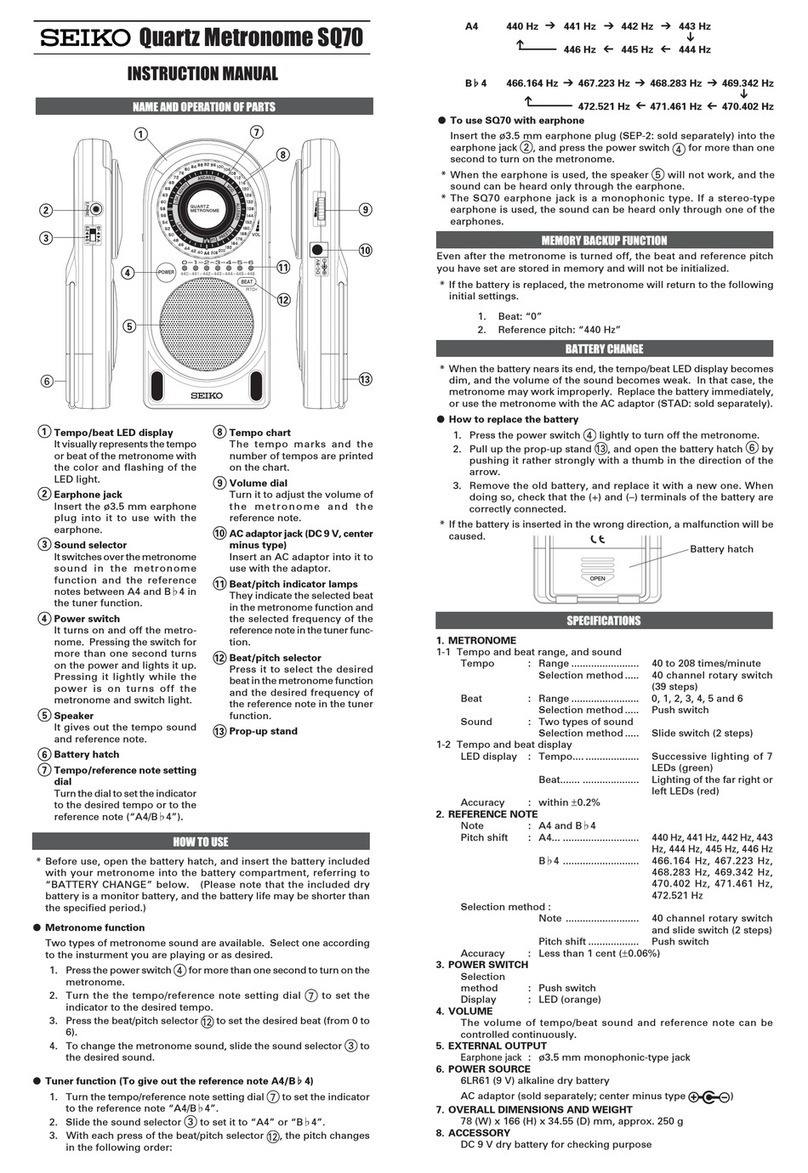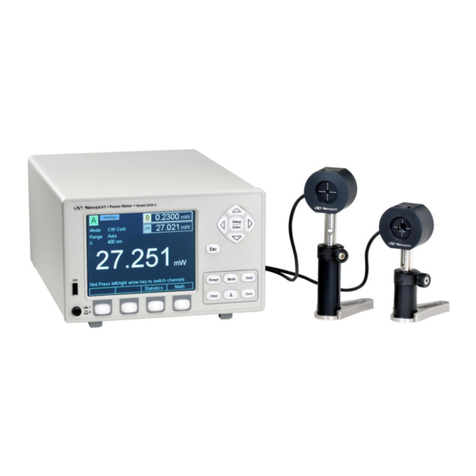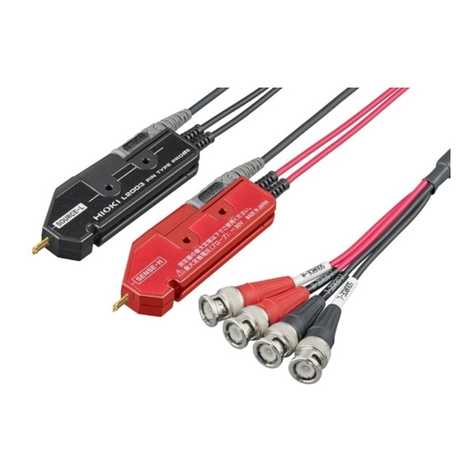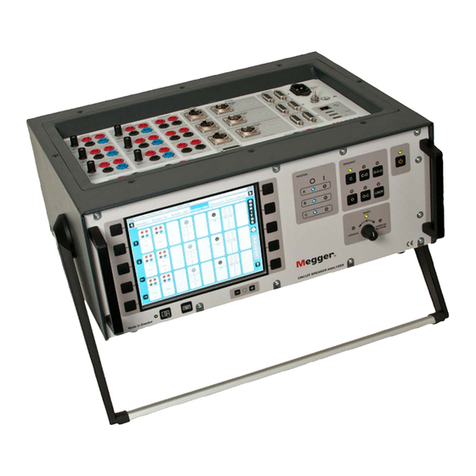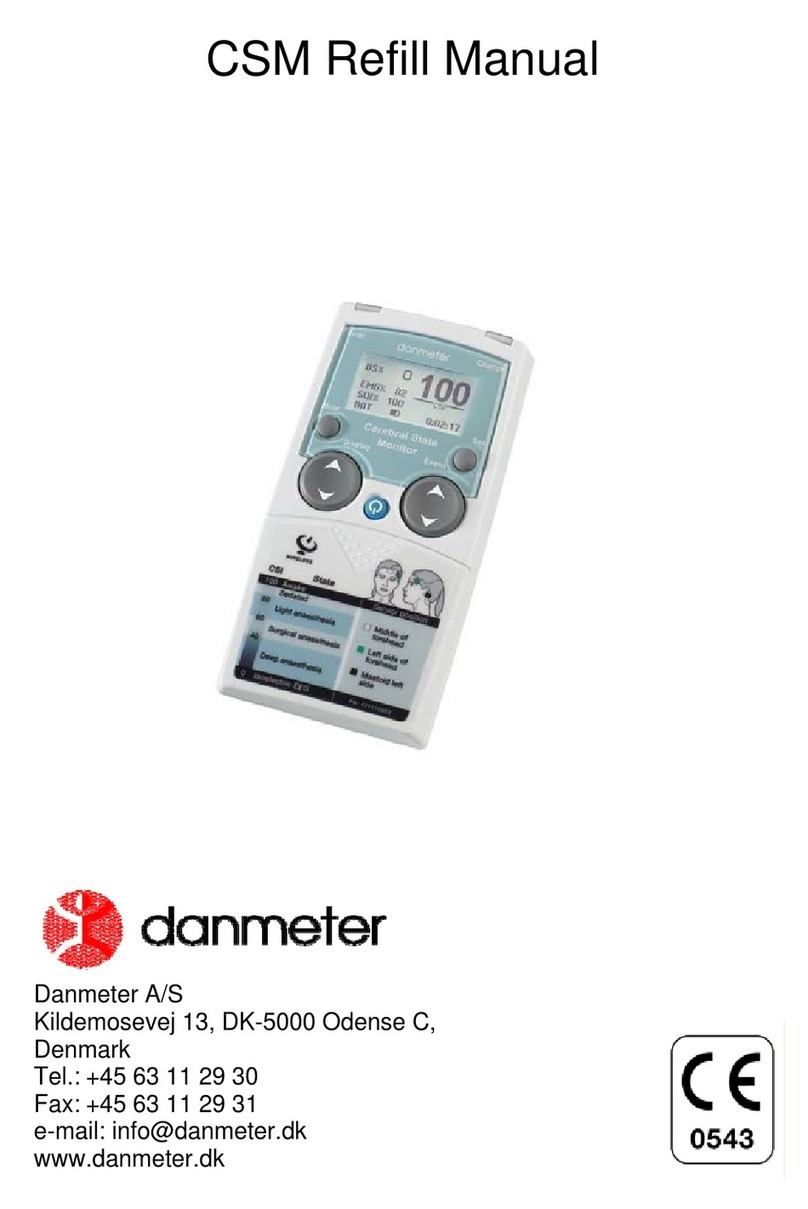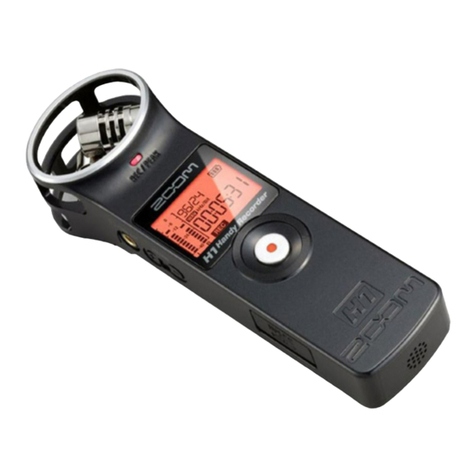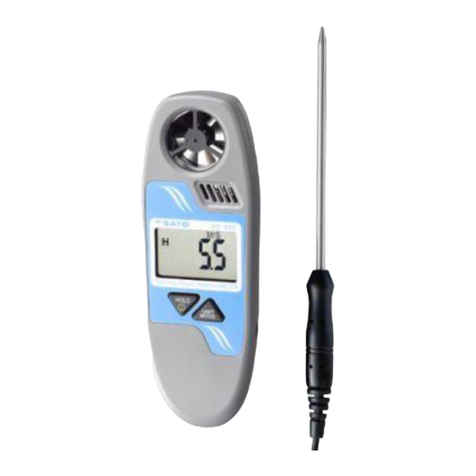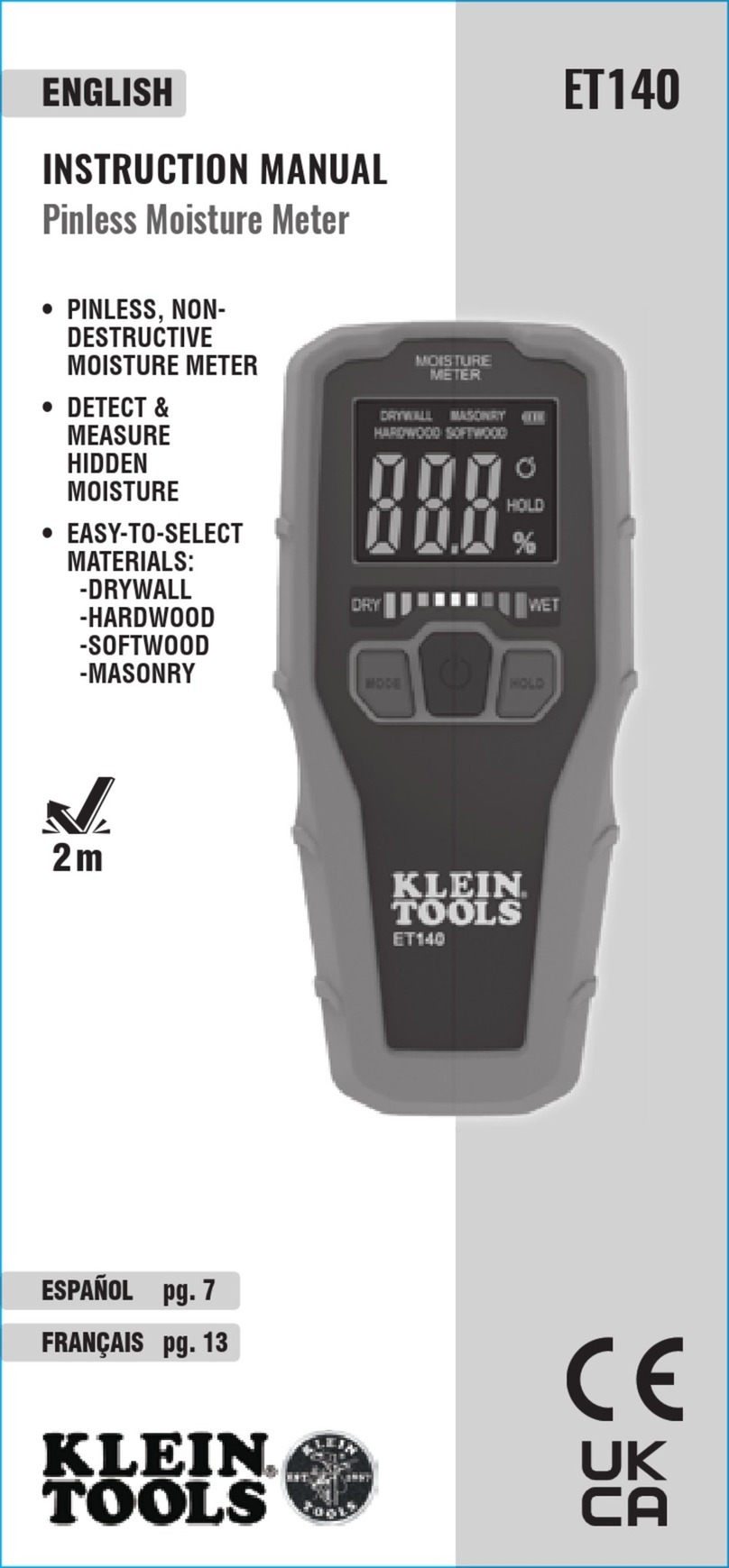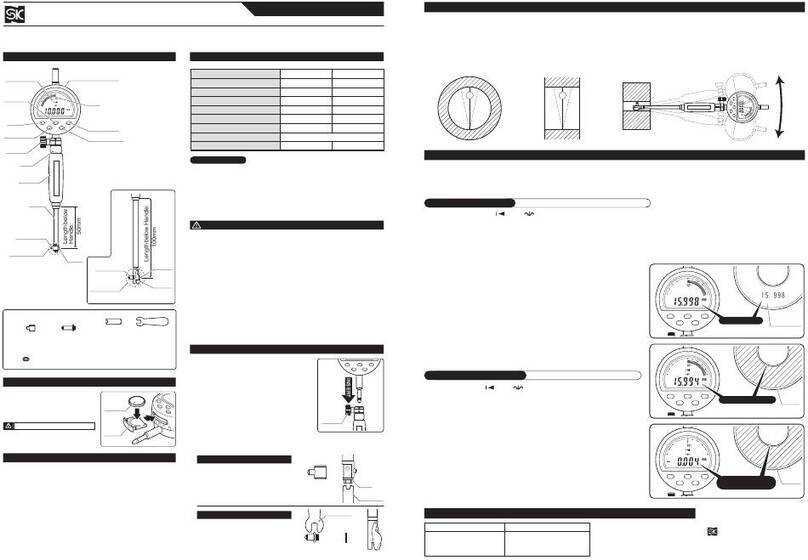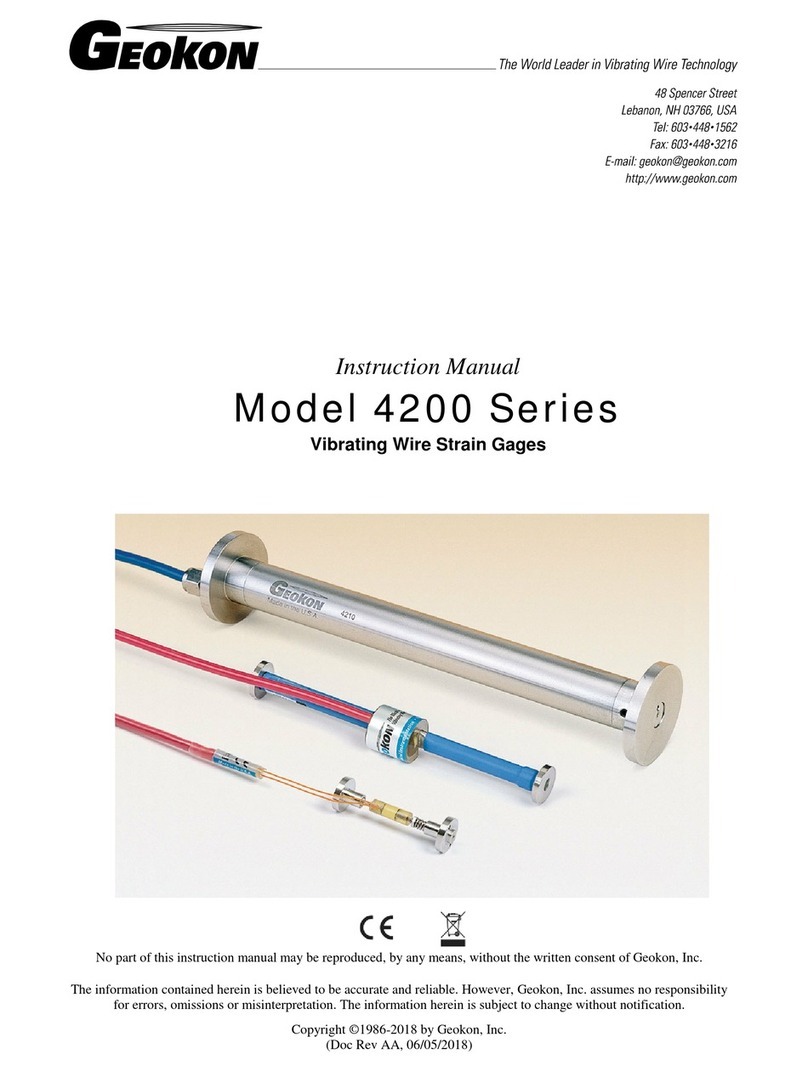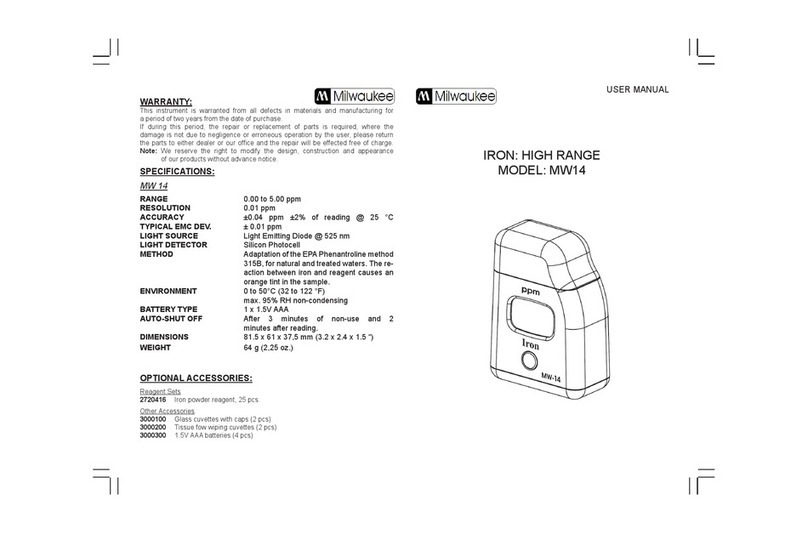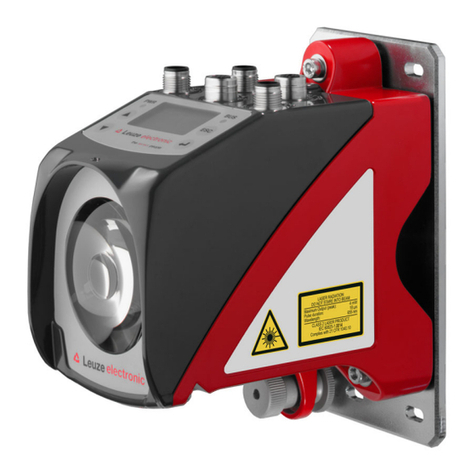Bartington Mag-01H User manual

Operation Manual for
Mag-01H Fluxgate Declinometer/Inclinometer
with non-magnetic Wild T1 Theodolite

THIS PAGE BLANK

BARTINGTON INSTRUMENTS
Page 3 of 32 OM2020/5
Table of Contents
1. About this Manual 5
1.1. Symbols Glossary 5
2. Safe Use 5
3. Introduction 6
3.1. The Null Method of Measurement 7
3.2. Resolution 7
4. The Magnetometer 9
4.1. Magnetometer Operation and Controls 9
4.2. The Probe 9
4.3. Electromagnetic Compatibility 10
5. The Theodolite 11
5.1. Night Viewing 13
5.2. Steep Sighting Prisms 13
5.3. Objective Sun and Orange Filters 13
6. Taking Measurements 14
6.1. Magnetic Hygiene 16
6.2. Theodolite Set-up 16
6.2.1. Levelling the Theodolite 16
6.2.2. Setting Over A Reference Point (Tripod Mounted) 17
6.2.3. Setting Over A Reference Point (Pillar Mounted) 17
6.3. Performing Observations of D&I with A Non-Resettable Horizontal Circle
Theodolite 18
6.4. Taking Readings 18
6.5. Performing Observation of Declination 19
6.6. Performing Observation of Inclination 21
7. Repair and Maintenance 22
7.1. Checking the System 22

BARTINGTON INSTRUMENTS
Page 4 of 32 OM2020/5
7.1.1. Battery Check 22
7.1.2. Functional Check 22
7.1.3. Theodolite Optical Check 22
7.2. Calibration 23
7.3. Probe Cable Repairs 23
7.3.1. Replacing the cable 25
7.3.2. Probe Electrical Resistance Values 25
7.4. Mag-01H Battery Replacement 25
7.5. Probe Alignment 26
7.5.1. Method 26
7.6. Offset Trimming 27
7.7. Cleaning the D/I System 27
8. Storage and Transport 28
9. End of Life Disposal 28
9.1. Waste Electrical and Electronic Equipment (WEEE) Regulations 29
Appendix 1: Observatory D/I Record Sheet 30
Appendix 2: Example International Geomagnetic Reference Field 31

BARTINGTON INSTRUMENTS
Page 5 of 32 OM2020/5
1. About this Manual
This document describes the installation, operation and maintenance of the Mag-01H Fluxgate
Declinometer/Inclinometer (D/I) System. It should be read in conjunction with:
• the product brochure DS0070
• operation manual OM0382, which describes the operation of the Mag-01H magnetometer
• the WildT1 theodolite operation manual.
• the training video for the use of the Mag-01H Fluxgate D/I System.
All are available on the Bartington Instruments website at www.bartington.com.
1.1. Symbols Glossary
The following symbols used within this manual call your attention to specific types of
information:
WARNING: Indicates a situation in which serious bodily injury or death could result if the
warning is ignored.
Caution: Indicates a situation in which bodily injury or damage to your instrument, or both,
could result if the caution is ignored.
Identifies items that must be disposed of safely to prevent unnecessary damage to the
environment.
Note: A note provides useful supporting information and sometimes suggests how to make
better use of your purchase.
2. Safe Use
WARNING: The Mag-01H is powered by mains electricity and contains uninsulated parts.
Ensure that the unit is properly earthed at all times. Only properly trained personnel
should carry out procedures in this manual which require the casing to be opened.
WARNING: These products are not qualified for use in explosive atmospheres or life
support systems. Consult Bartington Instruments for advice.

BARTINGTON INSTRUMENTS
Page 6 of 32 OM2020/5
3. Introduction
The Mag-01H Declinometer/Inclinometer (D/I) System comprises a high sensitivity, battery
powered, magnetometer type Mag-01H together with a vector sensing fluxgate Mag A probe
which is mounted on a Wild T1 non-magnetic theodolite.
The system permits very precise angular measurements of the terrestrial magnetic field F. The
angular components measured are Declination D and Inclination I.
• Declination is the azimuth angle between the Geographical Meridian GM and the Magnetic
Meridian MM.
• Inclination is the vertical angle between F and the horizontal measured in the direction of the
Magnetic Meridian.
The value of F, together with the components X (MM horizontal), Y and Z (vertical) may also be
measured to an accuracy of 0.25%.
The system is suitable for permanent installation on a non-magnetic pillar in observatories,
using a pillar mounting plate. The provision of a non-magnetic tripod and the re-chargeable
batteries within the magnetometer also permit mobile observatory use, enabling highly detailed
mapping of D and I.
See Taking Measurements for further details of taking measurements.
The system is used in observatories to obtain reference data which may be used in the
construction of Reference Field Charts. See Appendix 2 for an example of an International
Geomagnetic Reference Field (IGRF) chart.
Note: The Earth’s magnetic field is constantly changing. Current IGRF charts are available
from organisations such as the British Geological Survey (BGS) (www.geomag.bgs.ac.uk/).
Other applications include checking of compasses and monitoring of the field for compass
correction purposes, or in-field referencing in directional drilling operations. Detailed knowledge
of local variation in D and I may be of assistance in interpreting total field magnetometer survey
data.
The ultimate resolution achieved with this system is limited by four factors:
1. Prevailing magnetic conditions. Measurements during magnetic storms can be extremely
difficult to perform.
2. The degree of arc required. The Wild T1 theodolite has a resolution of 6 seconds of arc, with
estimates possible to 2 seconds.
3. Plinth stability. The tripod is less stable with time and temperature than a stone pillar.

BARTINGTON INSTRUMENTS
Page 7 of 32 OM2020/5
4. The noise level, and therefore resolution, of the magnetometer. Two sensitivity settings
are provided: x1, which produces a resolution of 1nT, and x10, which produces a resolution of
0.1nT. The x10 sensitivity setting would normally only be used under ideal conditions.
Note: The system is usually operated with the assigned magnetometer and theodolite
combination specified in the test documentation. Should a replacement magnetometer
be used, offset errors up to 5nT may be encountered. The accuracy of the system will not
be compromised provided that the four-measurement method described in this manual is
used.
3.1. The Null Method of Measurement
Measurements are obtained by operating the probe mounted on the theodolite in the null mode.
In this mode observations are performed with the probe orientated perpendicular to the direction
of the terrestrial magnetic field F. At an angle of 90° to the field the response of the probe
produces the greatest sensitivity to small changes in the field direction.
Note: Ultimate accuracy will depend on the prevailing magnetic conditions. The high
flexibility cable connecting the probe to the magnetometer does not interfere with the
measurement procedure and will operate down to very low temperatures.
Note: The use of low magnetic signature components within the Mag-01H instrument
enables this unit to be used close to the probe head. Errors will not be significant with
the probe and magnetometer as close as 0.5 metres, although the magnetometer is, in
practice, usually placed on the ground.
Variation in either D or I is indicated by d. Variation in Declination (dD) or Inclination (dI) around
a fixed null point can be continuously monitored via the analogue output. For small angular
changes, the relationship between magnetometer output and angle will be linear.
3.2. Resolution
The theoretical resolution R to small changes in field direction is proportional to the resolution
of the magnetometer and the strength of the perpendicular magnetic field. When measuring
Inclination, the magnetic axis of the probe is parallel to the vertical plane of investigation.
Therefore the full field strength F is available and the resolution becomes RdI = F sine dI.
When measuring Declination the magnetic axis of the probe is parallel to the horizontal plane
of investigation. As a result, only the horizontal field component H = F cosine I is available.
Therefore, for Declination measurements, the resolution becomes RdD = H sine dD.

BARTINGTON INSTRUMENTS
Page 8 of 32 OM2020/5
Note: At any magnetometer resolution, resolution of Inclination I is dependent on the
magnitude of F alone, whereas resolution of Declination D is dependent on H and I and will
generally vary with latitude.
Example (where F = 47,000nT, I = 67°):
On x1 sensitivity (1nT): RdI = circa 5 seconds RdD = circa 10 seconds
On x10 sensitivity (0.1nT): RdI = circa 0.5 seconds RdD = circa 1.0 seconds
Note: These are theoretical values and actual values will be determined by prevailing
conditions.
From the IGRF chart in Appendix 2 it can be seen that resolution in Declination is at a minimum
at the poles and at a maximum at the equator.

BARTINGTON INSTRUMENTS
Page 9 of 32 OM2020/5
4. The Magnetometer
4.1. Magnetometer Operation and Controls
See operation manual OM0382 for a description of the Mag-01H’s operation, and a description of
the front and rear panel controls.
4.2. The Probe
Figure 1. Theodolite mounted Mag A probe assembly.
Key to Figure 1
1. Enclosure lid 6. Mounting plate
2. Enclosure gasket 7. 5m cable to magnetometer
3. Blanking plates 8. Enclosure mounting screws
4. Enclosure 9. Fluxgate Mag A probe
5. Mounting plate screws 10. Probe mounting screws
The probe consists of a precision fluxgate magnetic field sensor mounted within a tube. A
joystick arrangement for trimming the alignment of the sensor relative to the tube is provided.
The probe is mounted on a pillar enclosed in a rugged housing, which fully protects it against
mechanical damage or potential misalignment. The probe and enclosure are individually
1
2
3
4
5
6
7
8
10
9
3

BARTINGTON INSTRUMENTS
Page 10 of 32 OM2020/5
attached to a mounting plate, which is retained by four screws to the theodolite telescope.
Gasket sealing is provided to prevent the ingress of moisture.
The instrument is supplied with the probe aligned parallel to the optical axis of the theodolite to
within 10 seconds of arc.
A high flexibility cable connects the probe to the electronics unit. If the cable is not already fitted
to the cover, follow the instructions for fitting in Probe Cable Repairs below.
4.3. Electromagnetic Compatibility
The Mag-01H instrument contains no high frequency electronics likely to cause emissions which
could affect other apparatus. The design, including the use of a rechargeable battery (charged
from a mains adaptor) and the decoupling of internal power supplies, is intended to produce
minimal emissions. Other equipment operating in the area is therefore unlikely to be affected.
Note: The unit itself is also unlikely to be affected by interference from other equipment in
the normal operating environment. However, the probe is designed to measure magnetic
fields and therefore is susceptible to electromagnetic interference. Operation close to a
high frequency source of radiation should be avoided. Interference is indicated by instability
in the reading when the probe is maintained in a fixed position.

BARTINGTON INSTRUMENTS
Page 11 of 32 OM2020/5
5. The Theodolite
Figure 2. Non-magnetic Wild T1 theodolite key operational features, view 1.
Key to Figure 2
11. High flexibility cable to
magnetometer 17. Pillar mount adaptor (Trivet)
12. Probe 18. Vertical circle adjustment
13. Micrometer 19. Tubular level
14. Vertical circle clamp 20. Scale focusing ring
15. Horizontal circle adjustment 21. Graticule focusing ring
16. Horizontal circle clamp 22. Telescope focusing ring
15
13
12
11
16
14
21
19
18
17
22
20

BARTINGTON INSTRUMENTS
Page 12 of 32 OM2020/5
Figure 3. Non-magnetic Wild T1 theodolite key operational features, view 2.
Key to Figure 3
23. Vertical circle housing 28. Horizontal circle housing
24. Steep sighting prism (Scale: non-
inverting) 29. Levelling screws
25. Steep sighting prism (Tekescope) 30. Circular level
26. Scale illuminator mirror 31. Optical plumb
27. Tubular level adjuster 32. Solar or orange filter
The Wild T1 is a 6-second accuracy, non-magnetic theodolite. The accuracy stated is for
the mean square of a single Circle Left (CL) measurement and a single Circle Right (CR)
23
29
31
25
27
24
30
32
26
28

BARTINGTON INSTRUMENTS
Page 13 of 32 OM2020/5
measurement. (Circle Left and Circle Right refer to the position of the vertical circle housing
relative to the observer: See Performing Observation of Declination.)
The theodolite undergoes a rigorous magnetic hygiene inspection at Bartington Instruments
prior to fitting the probe. Any contamination is totally removed to guarantee complete magnetic
cleanliness. Optical and magnetic calibrations are also carried out prior to despatch.
5.1. Night Viewing
The scale illumination lamp unit supplied by Wild is unsuitable due to its magnetic signature.
The alternative, recommended and supplied by Bartington, is a chemiluminescent light stick.
These are approximately 47mm length x circa 6 mm diameter. Bend the light stick to activate it
and place between the theodolite mirror and window to provide illumination.
Note: Night adjusted vision responds to this level of illumination, but below freezing point
the illumination may become inadequate.
5.2. Steep Sighting Prisms
When performing steep angled telescopic observations or attempting to perform null mode
magnetic measurements for shallow angles of I, a pair of steep sighting prisms will be required.
These will extend the vertical-viewing angle from circa 40° to 18°.
There are two types of prism. The larger type fits the telescope eyepiece and results in an
inverted image. The smaller prism fits the scale eyepiece and results in a non-inverted image.
5.3. Objective Sun and Orange Filters
The orange filter can be used to eliminate glare, for example, when viewing a target.
Check frequently that the filter is reliably fitted to the telescope objective lens during
observations.
WARNING: Failure to check, fit and use the sun filter when performing solar observations
may cause irreparable damage to the user’s eyes. Bartington Instruments can accept
NO liability for injuries resulting from solar observations, as we have no control over the
circumstances of use.
Note: The sun filter must be fitted when performing solar observations. It provides
an attenuation of above 1/100,000. Inspect the filter to ensure the free-floating silver
membrane is present and undamaged prior to use.

BARTINGTON INSTRUMENTS
Page 14 of 32 OM2020/5
6. Taking Measurements
This section describes the procedures for measurement of Declination and Inclination in the
null mode. Four readings are obtained for calculation of D and four readings are obtained
for calculation of I. Each set of four comprises two pairs of readings. One pair is averaged
to eliminate electronic offset errors and the other pair is averaged to eliminate mechanical
alignment errors (probe collimation).
Figure 4 describes the conventions in making observations for identifying the directions of
observation when performing null mode measurements. Figures 5 and 6 give further details of
the null mode of measurements.
Figure 4. Plan view of observation positions for D & I

BARTINGTON INSTRUMENTS
Page 15 of 32 OM2020/5
Figure 5. Observations of Declination in the horizontal circle.
Key to Figure 5
D. Angle of declination D (variation) is the azimuth angle between the geographical
meridian GM and the magnetic meridian MM.
F. The direction of the terrestrial field.
TD. Reference target datum.
Figure 6. Observations of Inclination in the vertical circle.
Key to Figure 6
I. Angle of inclination I (DIP) is the vertical angle of the terrestrial field F relative to
the horizontal plane. The plane of the vertical circle is set parallel to the magnetic
meridian MM.
O. The horizontal datum (O) is determined by the pendulum compensated vertical
reference (+Z).
In Figures 5 and 6, E, W, N and S refer to the direction in which the telescope is pointed, while U
and D refer to the position of the probe with respect to the telescope: Up (above the telescope)
and Down (below the telescope). Thus for example ED is East Down; NU is North Up etc.

BARTINGTON INSTRUMENTS
Page 16 of 32 OM2020/5
Declination is calculated from the mean of the four observations ED, WD, EU, WU. The reference
observation for Declination is the Geographical Meridian (GM) obtained using a Circle Left /
Circle Right observation to eliminate optical collimation errors.
The azimuth reference for Declination may be surveyed relative to the reference position of the
theodolite.
Declination must be discovered before Inclination can be measured. Inclination is calculated
from the mean of the four observations SU, ND, SD, NU with the telescope aligned with the
calculated Magnetic Meridian. The reference observation for Inclination is the horizontal plane,
which is automatically derived from the fluid filled gravity compensator in the vertical reference
within the theodolite. Observations are made on the vertical circle, the plane of which must be
parallel to the Magnetic Meridian.
It is customary to record the time in Universal Time (U.T.) at which each of the eight
measurements is recorded. The mean time for D and for I can then be calculated subsequently
for record purposes.
6.1. Magnetic Hygiene
Note: Before attempting magnetic observations, ensure adequate personal magnetic
hygiene. For example, garments should be free from steel fasteners or buckles.
Magnetic hygiene can be checked when commencing observations by moving hands, head and
torso close to the probe and observing any change in reading. Readings should not vary by more
than 0.2nT. In practice only the hand used for circle slow motion adjustment will be close to the
probe at critical times during measurement. Ultimate accuracy will depend on ambient magnetic
noise. The diurnal variation of the terrestrial field becomes most active at dawn and dusk.
6.2. Theodolite Set-up
For reference, see Figure 2 and Figure 3, and the WildT1 theodolite manual.
Note: When moving to a new site, allow at least 1 minute per 1K of temperature difference
to allow the theodolite to reach the ambient temperature.
To avoid ambiguous values for the magnetic meridian, place the theodolite on the pillar or tripod
such that the 0/360º horizontal circle transition will be clear of the four declination null point
readings.
6.2.1. Levelling the Theodolite
(See also the WildT1 theodolite manual.)
1. Use the three foot-screws to level the theodolite base using the circular level.

BARTINGTON INSTRUMENTS
Page 17 of 32 OM2020/5
2. Rotate the telescope to a horizontal position with the probe at the top and apply the vertical
clamp. Release the horizontal clamp and align the tubular level between any two foot-screws
A and B. Foot screws A and B should be turned in opposite directions by equal amounts until
the tubular level is centred.
3. Rotate the Theodolite clockwise by 90 degrees to align the tubular level with the third foot-
screw C, and adjust the level in that direction using foot-screw C. Rotate 180 degrees and
reduce any error by half, again using foot-screw C.
4. Rotate theodolite by 90 degrees clockwise. Note the position of the tubular level bubble.
Bring the bubble to a halfway position between this position and a centred position by turning
foot screws A and B by equal and opposite rotations.
5. Rotate theodolite by 90 degrees clockwise. Turning foot screw C bring the bubble to its mean
(halfway position).
6. Check that the bubble now remains in its mean position through full rotation.
7. Repeat the above steps as necessary, centring on the mean position until it remains stable.
6.2.2. Setting Over A Reference Point (Tripod Mounted)
1. Position the tripod (if used) over the ground reference point with its head level. Mount the
theodolite and level the instrument using the circular plate level and foot-screws.
2. To focus the optical plummet (tripod only) on the graticule, turn the eyepiece and focus on the
ground point by pulling or pushing the eyepiece tube. Line up the graticule and target point
by adjusting the tripod legs and/or instrument foot-screws as necessary.
3. Re-level the instrument with the foot-screws and complete fine centring by moving the
instrument on the tripod head. If necessary, repeat levelling and centring procedure until
instrument is level, directly over the ground point.
6.2.3. Setting Over A Reference Point (Pillar Mounted)
When siting the theodolite on a pillar, the procedure is similar to that in the previous; however,
when pillar mounted, the optical plummet would not be used and the pillar mounting plate would
be fitted to the theodolite.
Use the tubular plate level to level the theodolite to better than ±15”. Each 2mm interval
represents 30” error. If this cannot be achieved then there is a problem in the setting of the
tubular level. This error can be completely eliminated using an adjuster pin as follows.
1. Attempt to level with tubular level set in line with a pair of levelling screws.
2. Rotate to the next pair of levelling screws. Remove half the error using the tubular level
adjuster and half the error using both the level adjustment screws.

BARTINGTON INSTRUMENTS
Page 18 of 32 OM2020/5
3. Rotate to the next pair of levelling screws and repeat the adjustment.
4. Rotate and continue adjustment until the desired accuracy is achieved.
6.3. Performing Observations of D&I with A Non-Resettable Horizontal Circle
Theodolite
The re-settable circle previously provided on the steel equivalent theodolite is not required for
accurate measurement of D and I and has been eliminated. The likelihood of incorrect circle
settings is reduced and the best observation method is adopted.
Note: A digital calculator will be required which can convert degrees, minutes and seconds
to decimal values and vice-versa. Alternatively, computer programs are available to assist
with data reduction.
An accurate digital clock with a large display positioned away from the theodolite is also
required.
The observation conventions are described pictorially in Figures 4, 5 and 6.
Two optical and four magnetic measurements are performed for each observation, and the
results are averaged to eliminate system optical and magnetic errors. Worked examples are
given at the end of this section. The examples are for explanation only and do not show the
system errors.
6.4. Taking Readings
Note: After levelling the theodolite, the vertical and horizontal scales will be in a random
position.
1. Direct the theodolite at the reference target or a null field position. After aligning in the
direction of interest the circle graduation lines are unlikely to be exactly in the middle of the
double line index, and will more likely resemble those displayed in Figure 7, below.
2.
Micrometer
Scale

BARTINGTON INSTRUMENTS
Page 19 of 32 OM2020/5
Figure 7 Example of likely position of circle graduation lines.
3. To achieve a correct reading, turn the micrometer screw to align the circle graduation line
exactly in the middle of the double line index (see Figure 8 below).
Figure 8. Circle graduation line aligned exactly in middle of double line index.
4. Example: The vertical measurement displayed in Figure 8 is approximately 272°52’44’’.
Note: For further information refer to the Wild T1 manual, section 4.5.
6.5. Performing Observation of Declination
Connect the probe cable to the magnetometer and switch on the instrument. Prior to
commencing measurements, decide which sensitivity setting can be used. Attempt a trial null
measurement on x10 sensitivity (0.1nT resolution). If noise exceeds 0.5nT p-p then x1 sensitivity
setting should be used. This is recommended for most observations.
Note: Before taking readings on the Mag-01H, ensure that the offset control is set to zero
and the toggle switch is in a central position.
Note: A small offset error (a few nT) will be present when switching between the x1 and
x10 sensitivity settings. This in no way affects observation accuracy provided that the
sensitivity setting is not changed during any set of four measurements per observation. If
the audio null indicator is fitted, select an appropriate volume setting using the turn button
fitted on top of the Mag-01H.
For this observation a reference target with a known azimuth (TA) is required. This is the angle
subtended between the target and the Geographical Meridian (GM) at the point of observation.
The target azimuth can be surveyed using GPS measurements.
The setting of the horizontal circle will be arbitrary; therefore, the target datum (TD) reading
must be recorded first. With the circles unclamped, roughly align the telescope with the target
Micrometer
Scale

BARTINGTON INSTRUMENTS
Page 20 of 32 OM2020/5
and clamp both circles. Then use the vertical and horizontal circle adjustment controls to align
with the target.
1. Observe the target and record both the circle left (CL) and circle right (CR) horizontal circle
readings. Calculate the target datum (TD) as follows:
TD(±90°) = (CL + CR)/2
Note: this contains a ±90° component which will be subtracted when calculating D.
2. Set the vertical circle to 90º or 270º as appropriate, ensuring the micrometer scale reads
00’00’’ (see Figure 9).. Perform the four null mode magnetometer observations and
calculate the Magnetic Meridian mean value (MM).
Where MM = (ED + WD + EU + WU)/4
3. Calculate the Declination (D)
Where D = MM + (TA) - TD ± 90º
Select the value expected for D and reject the larger value.
Note: D will be positive if to the east and negative if to the west of GM. Observe correct use
of brackets and signs.
Figure 9. Magnetometer scale reading 00’00”
Example (ideal observations):
If:
TA = -30º
CL = 260º
CR = 80º
EU, WD = 14º
WU, ED = 194º
TD(±90°) = (CL + CR)/2
= (260º + 80º)/2
Micrometer
Scale
Table of contents
Other Bartington Measuring Instrument manuals
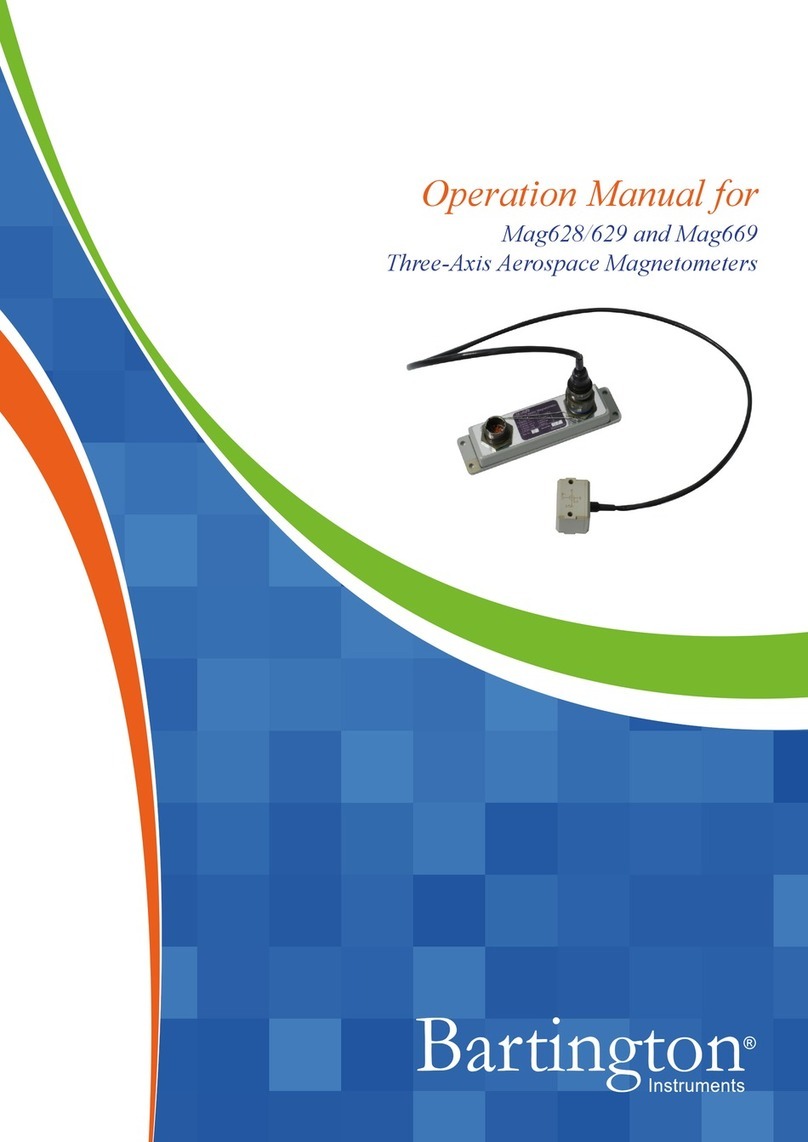
Bartington
Bartington Mag628 User manual
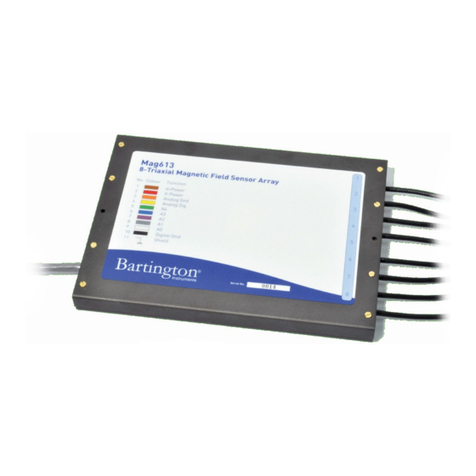
Bartington
Bartington Mag613 User manual
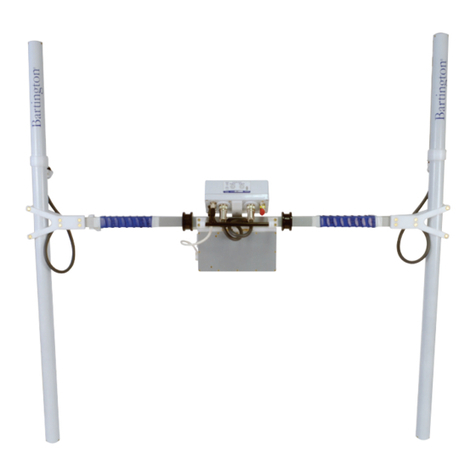
Bartington
Bartington Grad601 User manual

Bartington
Bartington Mag-01 User manual
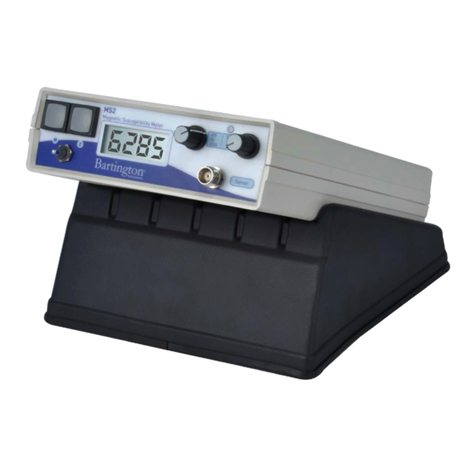
Bartington
Bartington MS2 User manual

Bartington
Bartington Grad-13 Series User manual
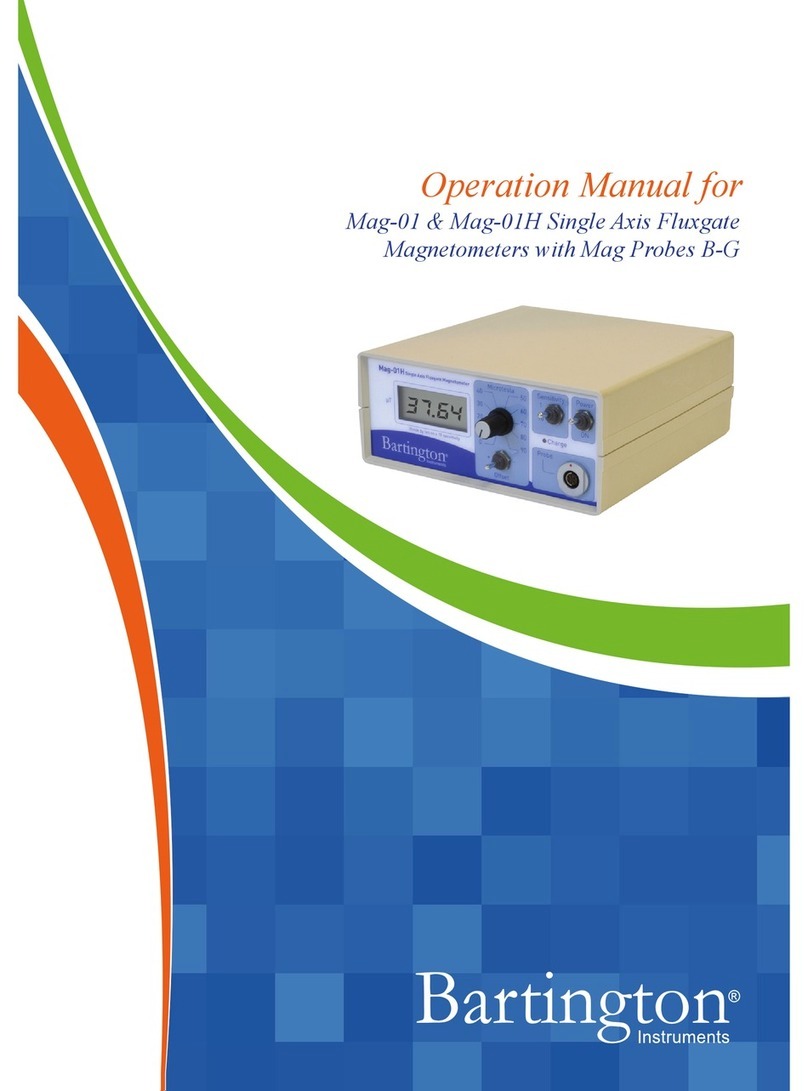
Bartington
Bartington Mag-01 User manual

Bartington
Bartington Mag690 User manual
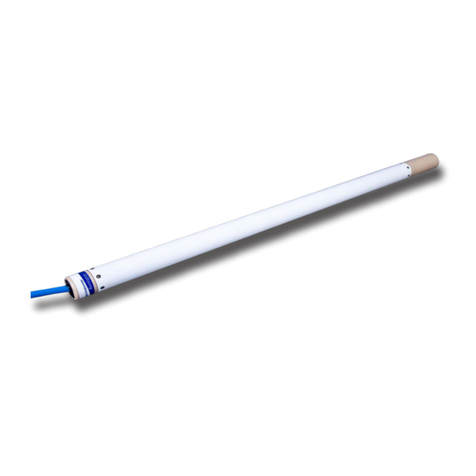
Bartington
Bartington Grad-13 Series User manual
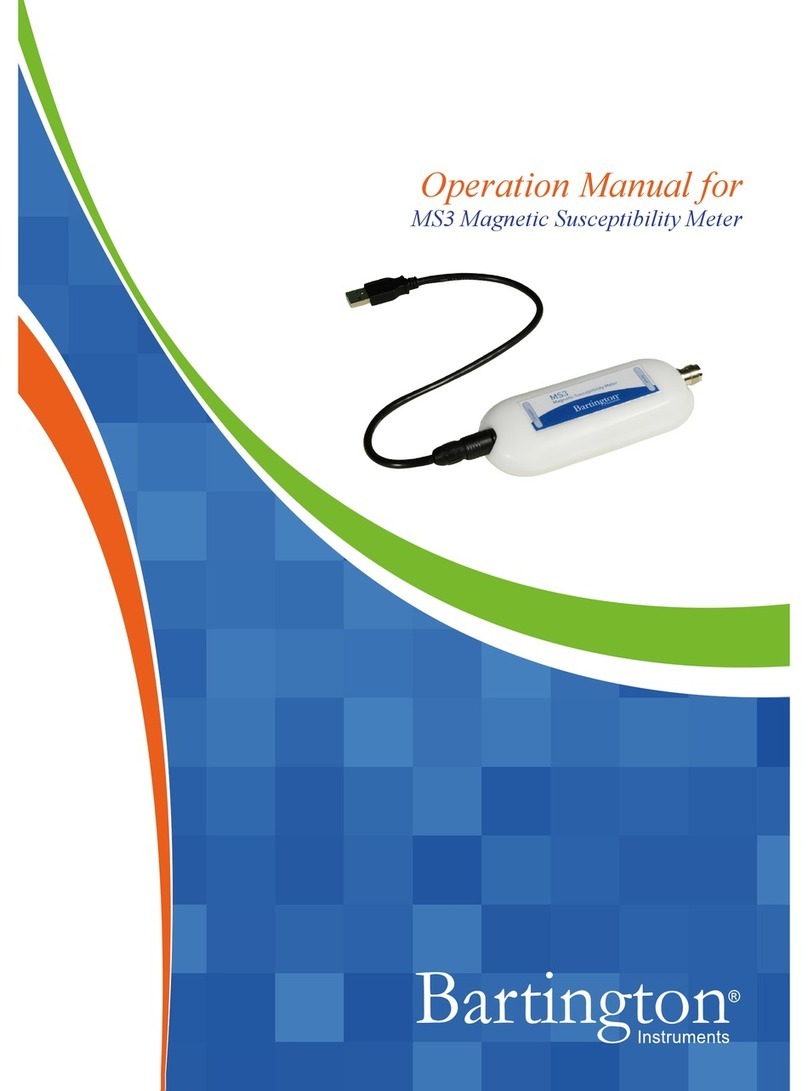
Bartington
Bartington MS3 User manual
